Descale and Clean a Coffee Machine Naturally
Love coffee but hate the cleanup? Discover how to descale and clean a coffee machine naturally using budget ingredients in your pantry. Preserves your machine’s performance while elevating your coffee’s flavor thanks to these tips.
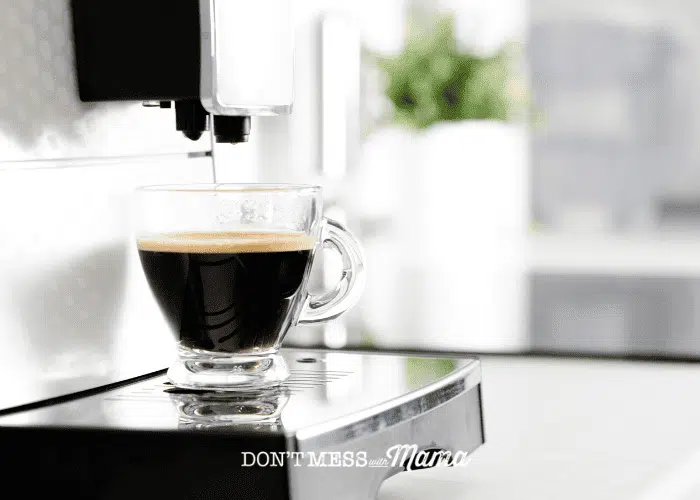
This post contains affiliate links. Please read my affiliate disclosure.
From paleo iced mochas to pumpkin spice frappes – it’s no secret that our family loves coffee. What I don’t love, however, is descaling and cleaning the coffee machine. The thought of pouring in commercial descaling powder leaves me with a bitter taste in my mouth. As an advocate for natural cleaning methods, I wanted to find the best ways to reduce mineral build up and clean a dirty machine without chemicals or harsh acids. Lucky for you, I’ve found not one but three solutions.
Descaling and cleaning your beloved coffee machine using natural methods will not only preserve its performance but also elevate the flavor of your coffee – it’s a win, win. Say goodbye to harsh chemicals and hello to a safer, simpler way to clean your coffee machine.
Benefits of Descaling a Coffee Machine Naturally
Using natural descaling agents like white vinegar or lemon juice is much more affordable compared to commercial descaling solutions. These household items are readily available and cost a fraction of the price of specialized descalers.
Not only that, but natural descaling agents like white vinegar and baking soda possess other cleaning powers. They can help remove coffee oils, stains, and residue from the coffee maker, giving you more value for money too.
1. Extends the life of the coffee machine
Regular descaling helps prevent limescale buildup, which can clog internal components and lead to mechanical issues. Unfortunately, some commercial descalers, while effective short term, contain acids that are corrosive, so may cause your machine more harm than good in the long run.
By keeping the machine free from mineral build-up naturally, you can extend its lifespan and avoid costly repairs or expensive replacements. Additionally, incorporating routine cleaning practices, like wiping down the exterior, cleaning the carafe or portafilter, and washing removable parts, will keep your coffee machine in top shape and your coffee tasting its best.
2. Improves taste of coffee
Limescale deposits can negatively impact the brewing process, affecting water flow and temperature consistency. When the coffee machine is clogged with mineral build-up, it may not extract the coffee grounds properly, resulting in under-extracted or over-extracted coffee.This can lead to a bitter or flat taste.
Following a descaling process with natural cleaning agents removes limescale and allows the machine to function at its best. This results in a better, more flavorful cup of coffee or espresso.
I also want to add that a common complaint with commercial descaling products is that they can leave behind a chemical taste or odor in the coffee maker, affecting the flavor of your morning brew. Natural descaling agents like white vinegar and lemon juice – when properly rinsed – do not leave any lingering taste or smell.

3. Environmentally friendly
Natural descaling methods are eco-friendly and pose fewer environmental risks compared to chemical-based descalers. Commercial descalers often contain harsh chemicals that can be harmful to the environment and may require special disposal methods.
On the other hand, the natural methods I’ve listed below are all biodegradable and safe for the environment. By choosing natural descaling options, you contribute to reducing chemical waste and promoting a greener approach to coffee machine maintenance.
4. Non-toxic and safe
A final benefit is that chemical descalers can leave residues that may be harmful if not rinsed thoroughly. Natural descaling agents are non-toxic and safe for use in food preparation areas. They are less likely to leave behind harmful residues, ensuring that your coffee remains free from any lingering chemical flavors or odors.
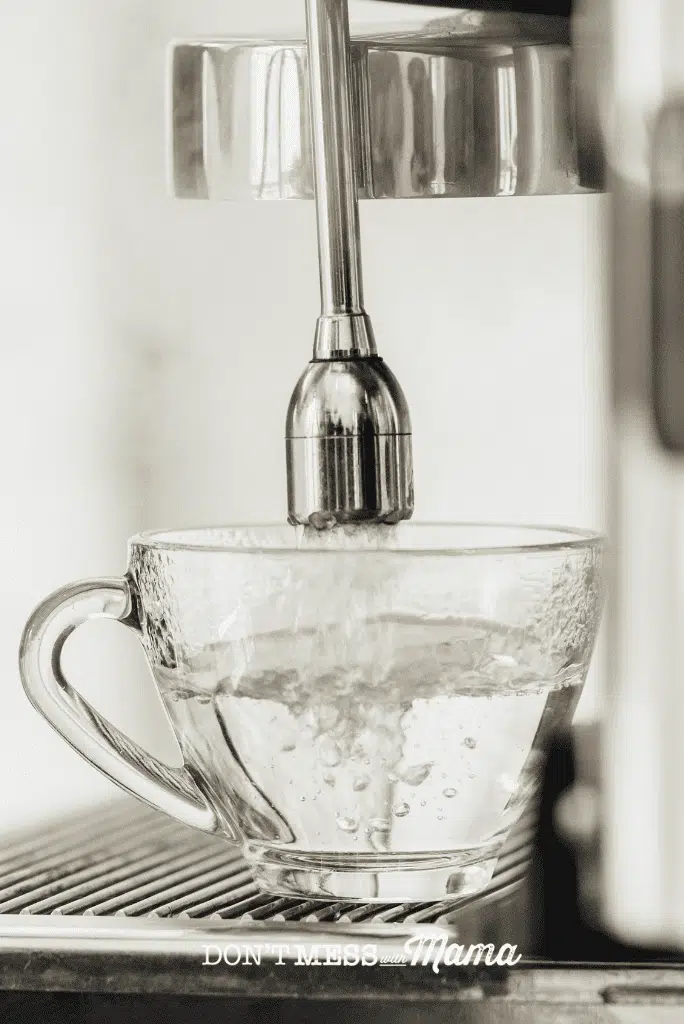
What causes buildup on coffee machines and espresso makers?
Build-up occurs in coffee machines and espresso makers due to the accumulation of minerals and impurities present in the water used during the brewing process. Over time, these minerals, such as calcium and magnesium, form limescale buildup, especially in areas with hard water. Additionally, coffee oils and residue from previous brews can also build up, affecting the machine’s performance and the quality of your coffee.
Signs Your Coffee Machine Needs Descaling
1. Slow Brewing
If you notice that your coffee maker is taking longer than usual to brew a pot of coffee or your espresso machine’s extraction is sluggish, it could be a sign of limescale build-up clogging the internal components and water pathways.
2. Reduced Water Flow
If your coffee machine needs descaling you’ll notice a decrease in the water flow during the brewing process. This is a clear indicator of mineral deposits obstructing the machine’s pipes and heating elements. This can lead to uneven brewing and weaker coffee.
3. Machine Malfunctions
Limescale buildup can cause mechanical issues in your coffee machine. This can include issues such as clogged valves or malfunctioning pumps, resulting in inconsistent performance or complete breakdowns.
4. Bitter Taste
When limescale builds up in the brewing system, it can affect the temperature and pressure. This can lead to the over-extraction of coffee grounds producing a bitter, unpleasant taste in your coffee or espresso.

3 Natural Ways to Descale and Clean a Coffee Machine
1. White Vinegar Method
White vinegar contains acetic acid, which makes it an excellent descaling agent. When it comes into contact with limescale, the acid reacts with the mineral deposits, breaking them down and dissolving them. This process effectively helps to remove the stubborn build-up from various parts of the coffee machine.
Ingredients:
- White vinegar
- Water
Instructions:
- Make a vinegar solution with equal parts white vinegar and water. For a standard descaling, I recommend about 1 cup of white vinegar and 1 cup of water.
- Empty any leftover coffee or used coffee grounds from the coffee maker.
- Pour the vinegar solution into the water reservoir of the coffee maker.
- Place an empty coffee filter in the brew basket.
- Start the brewing cycle as if you were making a pot of coffee, allowing the vinegar solution to run through the machine.
- After the brewing cycle is complete, turn off the coffee maker. Let the solution sit for about 15 minutes to further dissolve the limescale.
- Discard the used solution and run two more cycles with clean water to rinse out any remaining vinegar taste.
- Wipe down external surfaces including the water reservoir and drip tray using a mild detergent or household cleaner such as thieves household cleaner.

2. Lemon Juice Method
Lemon juice contains natural acids (predominantly citric acid) which makes it an effective descaling agent. These acids work to break down and dissolve mineral deposits, which helps to remove limescale from the coffee machine’s internal components. One advantage that lemon juice has over vinegar is its pleasant citrus smell. While vinegar may leave behind a sharp odor, lemon juice leaves a refreshing scent, which can overpower any stale coffee smells in the machine.
Ingredients:
- Fresh lemon juice
- Water
Instructions:
- Squeeze the juice from a fresh lemon, straining out any seeds.
- Mix the lemon juice with an equal amount of water to create a natural descaling solution.
- Follow the same steps as the White Vinegar Method, using the lemon juice-water mixture instead of white vinegar. Place the solution in the water reservoir, use an empty coffee filter in the brew basket, and run it through the machine.
- Allow the lemon juice solution to sit in the carafe for about 15 minutes after the brewing cycle. This will help to maximize the descaling.
- Discard the used solution and run two more cycles with clean water to rinse out any lemon flavor.
- Finish by cleaning the external surfaces including the water reservoir and drip tray.

3. Baking Soda Method
There are so many uses for baking soda around your home, including cleaning and descaling your coffee machine. While it may not contain acidic properties like white vinegar or lemon juice, baking soda offers unique cleaning benefits that make it a popular choice for descaling coffee machines naturally. Firstly, it’s a gentle abrasive, which means its effective at removing light mineral deposits and coffee residue that may accumulate in the machine over time. It can help scrub away surface stains without causing damage to the machine’s internal components (also why I swear by it in my DIY soft scrub cleaner.)
Baking soda is also known for its odor-absorbing properties, so can help neutralize any unwanted smells from your coffee machine. It is also non-toxic and safe to use on a variety of surfaces, including those commonly found in coffee machines, such as glass, stainless steel, and plastic.
Ingredients:
- Baking soda
- Water
Instructions:
- In a small bowl, mix 1-2 tablespoons of baking soda with enough water to form a thick paste.
- Apply the baking soda paste to any stubborn limescale deposits or stains inside the coffee maker. These can usually be found in the water reservoir or coffee pot.
- Use a soft brush or toothbrush to gently scrub the affected areas with the baking soda paste to help break down the mineral deposits.
- Rinse the coffee maker thoroughly with clean water to remove any remaining baking soda residue.
- Run a brewing cycle with clean water to flush out any loose debris and ensure the machine is ready for use.
- Don’t forget to clean the external surfaces of the coffee maker, including the water reservoir and drip tray, using mild detergent (such as Thieves household cleaner) and a clean cloth.
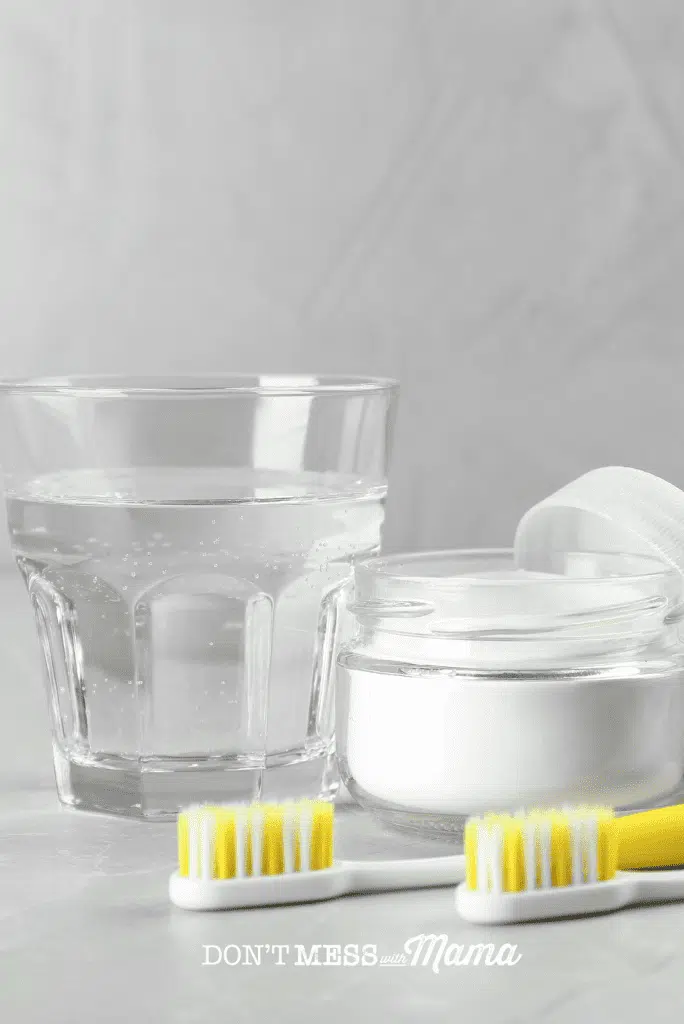
How to Prevent Limescale Build-up
Preventing limescale build-up in the first place will make cleaning your coffee machine so much easier. Here are my top tips to help you prevent limescale build up:
- Use filtered or soft water: Hard water contains higher levels of minerals that contribute to limescale formation. Consider using filtered water or invest in a water softener to reduce the mineral content in the water you use for brewing coffee. I have used a Berkey water filter for over 8 years now and highly recommend it.
- Regularly descale your coffee machine: Follow the natural descaling methods mentioned above (white vinegar, lemon juice, or baking soda) to remove any existing limescale build-up. Then, establish a descaling routine based on how regularly you use your coffee machine and the hardness of your water.
- Clean the water reservoir and parts: Regularly clean the water reservoir and removable parts of your coffee machine, such as the carafe and brew basket, to prevent coffee oils and residues from contributing to limescale build-up.
- Avoid leaving water in the machine: Empty the water reservoir after each use, especially if you won’t be using the coffee maker for a while. Stagnant water can promote limescale.
- Store your coffee machine properly: When not in use, keep your coffee machine in a dry and clean environment to minimize the risk of limescale formation.
How often should I descale a coffee machine?
How often you need to descale your coffee machine depends on a few factors. For example, espresso machines with boilers may require more frequent descaling compared to drip coffee makers. If you use your coffee machine daily or live in an area of hard water, it will also need descaled more frequently.
Always refer to the machine’s user manual for specific descaling recommendations. Some coffee machines actually give you a maintenance reminder when it’s time to descale.
As a general guide:
- For coffee machines using hard water: Descaling every 1 to 2 months is a good rule of thumb to prevent significant limescale build-up.
- For coffee machines using soft or filtered water: Descaling every 3 to 6 months may be sufficient, but it’s still essential to monitor the machine for any signs of limescale.
- Espresso machines: Espresso machines typically require more frequent descaling, especially if you use them regularly. Depending on the hardness of your water, descaling every 1 to 3 months is advisable.
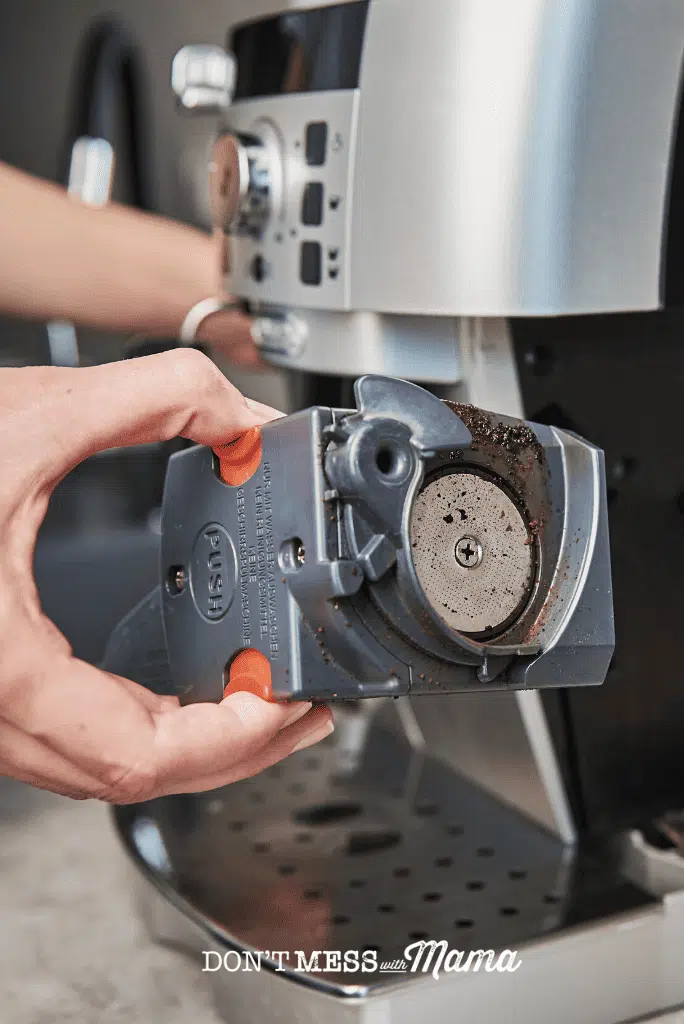
Will using natural descaling methods affect the taste of my coffee?
Using natural descaling methods, such as white vinegar, lemon juice, or baking soda, should not impact the taste of your coffee if you follow the proper descaling methods noted above.
It’s also essential to ensure that you rinse the coffee machine thoroughly with clean water after the descaling process. This step is crucial in removing any remaining traces of the descaling solution from the machine. If there are lingering residues, they could potentially affect the flavor of your coffee.
As a tip I always perform a taste test. After descaling and rinsing, brew a small cup of coffee and taste it. If you detect any unusual or off-flavors, run more water-only cycles until the taste returns to normal.
Can I descale a coffee machine naturally if it’s a pod-based or capsule coffee maker?
Natural methods can be used to remove limescale and mineral build up regardless of the type of coffee machine, including pod-based or capsule coffee makers. The steps for descaling a pod-based or capsule coffee maker using natural methods are similar to those for other types of coffee machines. Always refer to the coffee maker’s manual for specific descaling recommendations and guidelines for your particular model.
Can I descale a single-serve coffee machine, such as a Keurig machine, using natural methods?
Yes, you can descale a single-serve coffee machine, such as a Keurig machine, using natural methods. Single-serve coffee machines like Keurig brewers can benefit from regular descaling to remove mineral deposits and limescale that may accumulate over time. The natural descaling agents I have suggested including white vinegar, lemon juice and baking soda are safe to use in these machines.
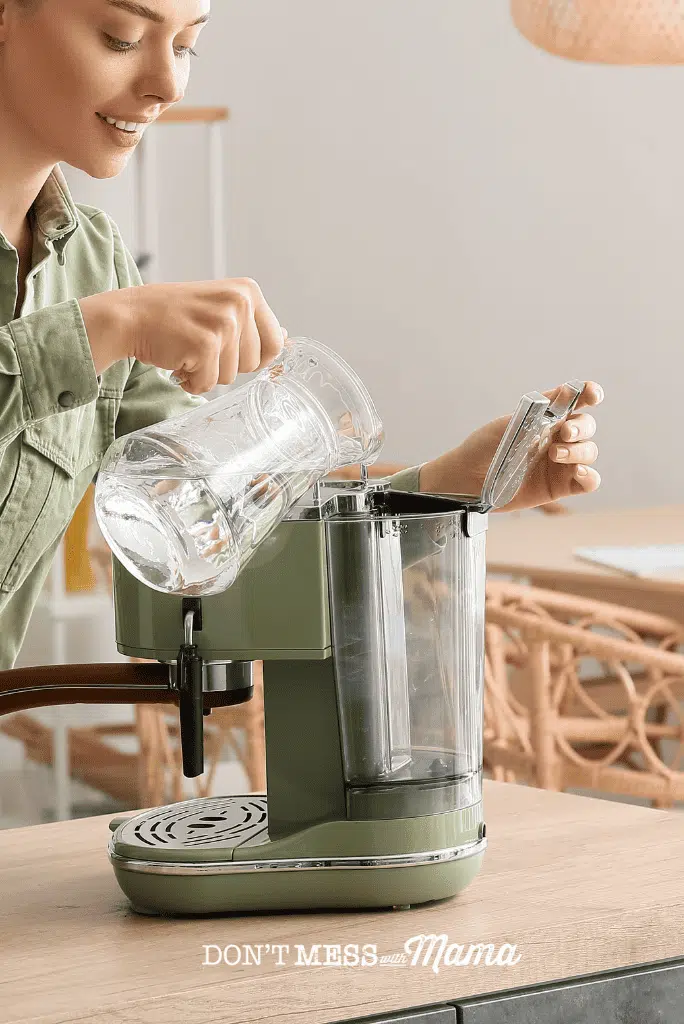
Hopefully I’ve inspired you to embrace natural methods to descale your coffee machine after learning these tips and benefits. Whether you opt for the mild abrasiveness of baking soda, the refreshing scent of lemon juice, or the powerful acidity of white vinegar, these eco-friendly solutions effectively tackle mineral build-up without harsh chemicals. Not only will your coffee machine’s performance be preserved, but your morning coffee will also taste even better.
More Posts You Might Like
- How to Remove Coffee Stains From Teeth
- How to Clean and Organize Your Fridge
- How to Clean an Instant Pot
Did you try these methods to descale and clean your coffee machine? Don’t forget to comment below to let me know how it went. You can also FOLLOW ME on Facebook, Instagram and Pinterest.
